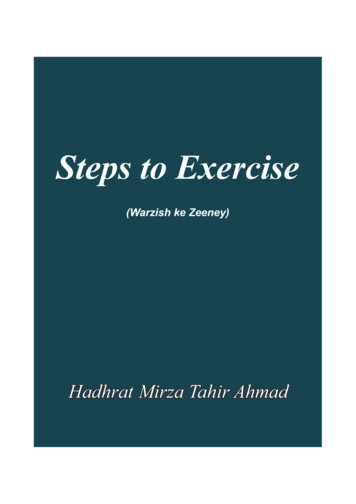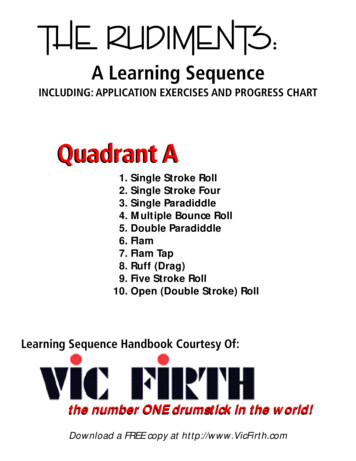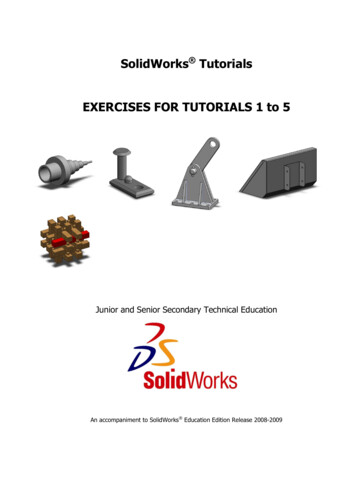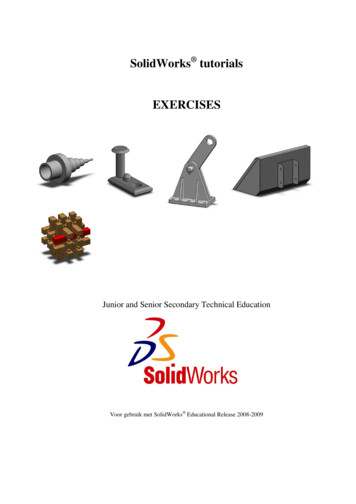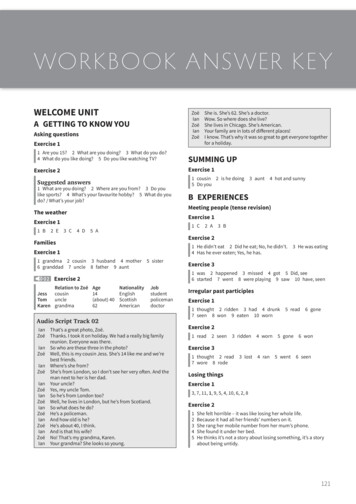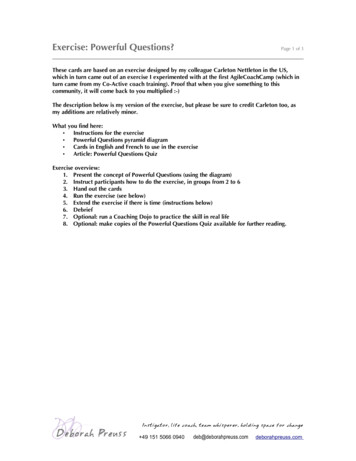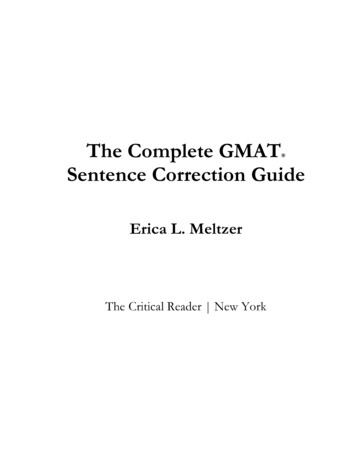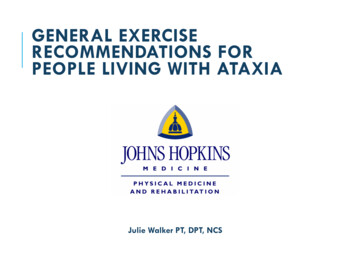
Transcription
GENERAL EXERCISERECOMMENDATIONS FORPEOPLE LIVING WITH ATAXIAJulie Walker PT, DPT, NCS
*DISCLAIMER*Please consult with your primary careprovider, neurologist, or other healthcare provider about any advice,exercise, therapies, medication,treatment, nutritional supplement, orregimen that may have beenmentioned as part of any presentation
OBJECTIVES By the end of the session thelearner should be able to: Discuss common challenges to function Discuss the benefits of exercise Identify current literature Identify available PT resources
WHAT IS THE ROLE OF THECEREBELLUM?Center for Balance,Coordination, andLearningControls all Motorbehavior Limb Movements Trunk Movements Eye Movements Speech
ATAXIA SYMPTOMS Impaired Coordination Difficulty with reaching forobjects or writing Decreased balance Impairments with posturaladjustments and control ofbalance Difficulty Walking Varied step placement due totrouble with leg coordination Trouble controlling eyemovements Slurring of speech NO WEAKNESS Feel “weak” due to impairedmotor control
BALANCE SYSTEMSVisionSomatosensoryVestibular
WHAT ABOUT WALKING?Decreased Coordination in Legs and Trunk Impaired Balance Variability of stepsIncreased FallsFatigue
WHAT IS A BETTER PREDICTOR OFIMPROVED QUALITY OFWALKING? A: LegPlacement(coordination)Answer:Balance(Morton and Bastian 2003) B: Balance
(Morton and Bastian 2003)
AMERICAN COLLEGE OF SPORTSMEDICINEEXERCISE RECOMMENDATIONS
ACSM: AEROBIC EXERCISE Frequency: 5 days a week of moderateexercise, or 3 days a week of vigorous exercise Intensity: Moderate and/or Vigorous Intensity Duration: 30-60 minutes a day, total 150 minutes a week ofpurposeful moderate exercise Mode: Regular, purposeful exercise that involves major musclegroups and is continuous and rhythmic in nature Exercise may be performed in one continuous sessionper day or in multiple sessions of more than 10 minutesto accumulate the desired duration and volume ofexercise per day
ACSM: RESISTANCE EXERCISE Frequency: Each major muscle group shouldbe trained 2-3 days a week Intensity: 60-70% of the 1 repetition max Repetitions: 8-12 repetitions Sets: 2-4 sets to improve strength and power Rest: Rest 48 hours between sessions for any single muscle group Decrease intensity and increase repetitions to improvemuscular endurance
ACSM: FLEXIBILITY EXERCISE Frequency: 2-3 days a week Intensity: Stretch to the point of feeling tightness or slightdiscomfort Duration: Hold a static stretch for 30-60 seconds Mode: Series of flexibility exercises for each of themajor muscle-tendon units Flexibility exercise is most effective when the muscle iswarmed through light to moderate aerobic activity orpassively through external methods such as moist heatpacks.
ACSM: NEUROMOTOREXERCISE Frequency: 2-3 days a week Intensity: Unknown Duration: 20-30 minutes per day Mode: balance, agility, coordination, gait Methods for optimal progression are not known
EVIDENCE IN THE LITERATURE Why is Exercise soImportant? What can it help mebe able to do? How can I startexercising and whatshould I do forexercise?
CAN EXERCISE SLOW DISEASEPROGRESSION?Exercise may help regain functionalperformance of one or more years ofthe disease progression (miyai, ilg) SARA scores may worsen 0.4 to 2.2 points per year depending ontype of ataxia (Jacobi 2011) Intensive Coordination Therapy studies have shown SARA Scoresimprove up to 5.2 points Gaining 2 or More YEARS of diseaseprogression (Miyai, Ilg 2009)
WHAT ARE YOUR GOALS?Infrequent FallerFrequent Faller Improve Dynamic balance Improve task specific skills Decrease falls risk Transfer training Prevent need for an assistivedevice Improve Static Balance Playing sports etc. Decrease FallsSet and establish goals with help of a Physical Therapist
EXAMPLES OF GOALS:Infrequent FallerFrequent Faller Talk to family while walking Be able to transfer from thebed to a chair without help Walk and carry somethingwithout spilling it Negotiate a curb safely Be able to play catch with myson Stand in the kitchen and talk tofamily without having to holdonto the counter Use the regular chair at arestaurant instead of mywheelchair
BENEFITS OF BALANCETRAINING Improved Quality of Walking Decreased Variability of steps Decreased Variability of sway Improved Walking Speed Reduces Risk of Falls Improves Motor PlanningIlg 2009, 2015; Bastian and Keller 2014
INTENSIVE COORDINATIVE TRAININGIMPROVES MOTOR PERFORMANCE INDEGENERATIVECEREBELLARDISEASEILG ET AL. 2009 Patients 16 patients 10 with Cerebellar Ataxia 6 with Sensory Ataxia Intervention 4 weeks of Intensive therapy witha therapist 3x a week for 1 hour sessions Results Decline of average of 5.2 pointson SARA Increased Gait Speed Less Variability of step placementAll equal less riskfor falls!
WHAT DID THEY DO FOREXERCISE?Static Balance ExercisesDynamic Balance Exercises Standing with varied feetposition Kneeling with arm movement Sitting on varied surfaces Stepping while standing Climbing stairs Side stepping Walking on uneven ground
EXERCISES TO PREVENT FALLS Stepping in multiple directions External perturbations by the therapist whilestanding or moving Quadruped (on all 4s) and practice of floortransfers Squatting and standing back up
6 WEEK HOME EXERCISE STUDYFOR PEOPLE WITH CEREBELLARDAMAGE(KELLER, BASTIAN 2014) Patients 14 patients with cerebellarataxia Assessments Walking speed Walking balance tests Intervention Home Physical Therapy
SITTING BALANCE EXERCISESMovement on Varied Support SurfacesAdapted from Jennifer Keller
STANDING BALANCEEXERCISESAdapted from Jennifer Keller
Tests that were not directly part of thetraining improved!RESULTSAdapted from JenniferKeller
WHAT WAS THE KEY TOIMPROVEMENT?Participantswho ratedthe exercisesas morechallengingimproved themost (Bastian Keller2014)
WHAT IS THE KEY FOREXERCISE? Exercise needs to be CHALLENGINGenough to be beneficial Periodically review your home program with your PT Exercise needs to beSAFE to prevent falls Exercise with advice from a Neuro PT Motor Learning is achieved withREPETITION and reinforcement(Therrian 2016)
HOW DO YOU FIND ANEURO PT? Google: Find a PT Near Me
Questions?
SPECIAL THANKS TO: Jennifer Keller Jennifer Millar Amy Bastian The Johns Hopkins Ataxia Clinic
REFERENCESBastian AJ. Learning to predict the future: the cerebellum adapts feedforward movement control. Curr Opin Neurobiol 2006,16(6): 645-649.Fonteyn EM, Physiotherapy in Degenerative Cerebellar Ataxias: Utilization, Patient Satisfaction, and Professional Expertise.Cerebellum (2013) 12:841–847Ilg W, Synofzik M, Brotz D, Burkard S, Giese MA, Schols L. Intensive coordinative training improves motor performance indegenerative cerebellar disease. Neurol 2009; 79 (20):2056-2060.Ilg W, Schatton C, Schicks J, Giese M, Schols L, Synofzik M. Video game based coordinative training improves ataxia inchildren with degenerative ataxia. Neurology. 2012; 79: 2056-2060.Keller JL, Bastian AJ. A home balance exercise program improves walking in people with cerebellar ataxia. Neurorehabilitationand Neural Repair. 2014; 28(8): 770-778.Morton SM, Bastian AJ. Relative contributions of balance and voluntary leg-coordination deficits to cerebellar gait ataxia. JNeurophysiol 2003; 89(4): 1844-1856.Morton SM, Bastian AJ. Cerebellar control of balance and locomotion. Neuroscientist 2004; June (10): 247-59.Morton SM, Bastian AJ. Cerebellar contributions to locomotor adaptations during splitbelt treadmill walking. J Neurosci2006, 26(36): 9107-9116.Synofzik M, Ilg W, Motor Training in Degenerative Spinocerebellar Disease: Ataxia-Specific Improvements by IntensivePhysiotherapy and Exergames. BioMed Research International 2014 Review Article ID 583507Therrien AS, Wolpert DM, Bastian AJ. Effective reinforcement learning following cerebellar damage requires a balancebetween exploration and motor noise. Brain 2016, 139(1):101-14.
Home Physical Therapy. SITTING BALANCE EXERCISES Movement on Varied Support Surfaces Adapted from Jennifer Keller. STANDING BALANCE EXERCISES Adapted from Jennifer Keller. RESULTS Tests that were not directly part of the training improved! Adapted from Jenni




